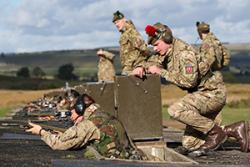Innovation in Armed Forces training
 Army recruits in training.A project which has transformed recruitment training in the British Army and led to changes in the delivery of training across all three UK Armed Forces, has been highlighted at �鶹��ý����� recently, by winning one of the University’s first Enterprise and Impact Awards.
Army recruits in training.A project which has transformed recruitment training in the British Army and led to changes in the delivery of training across all three UK Armed Forces, has been highlighted at �鶹��ý����� recently, by winning one of the University’s first Enterprise and Impact Awards.
Over ten years of research and implementation, in partnership with the British Army Recruitment & Training Division, the research has led to changes in the delivery of training across the three UK Armed Services, the formation of a new training establishment, the formation of a new tri-service monitoring and training body, better levels of performance and mental health in military recruits, and significant reductions in wastage (attrition) rates (up to 15%). The innovative work has been led by Professor Hardy and his team at the ’ .
The Bangor model developed by this research has spread across the Atlantic, having also been used by the Canadian and US armed services. The project addressed high wastage due to failure or withdrawal of recruits, an element which because of the high standards of performance required has always been a problem for the Armed Services. The model developed and promoted within the Recruitment & Training Division reduced wastage by using enhanced training practices. The research, funded by the Ministry of Defence, focused on the benefits of training non-commissioned officers involved in the delivery of recruit training in transformational leadership and coaching skills.
Professor Lew Hardy explained further, saying that 'train in, not select out' has become a bit of a motto in Army training:
“We introduced the latest theories from organisational and sport psychology to improve training for initial recruits and NCOs and provide improved training and leadership skills to the trainers within those sections.
"We've worked closely with the different parts of the Army to help them define their goals and then develop programmes that they can deliver to achieve those goals. It was quite important that we worked closely with the Army to develop a programme that the Armed Forces could deliver themselves. We helped the Army staff acquire the skills and knowledge to deliver the training- as we knew we'd have little 'street-cred' within the Army ourselves."
"The Army and other Armed Forces have not become ‘softer’ in their approach to training The Army and other Armed Forces have not become ‘softer’ in their approach to training.. For example, the main training objective for initial training is to transform raw recruits, more often than not, youngsters, who often come from difficult backgrounds, into mentally resilient soldiers who will perform under the most intense pressure imaginable, where mistakes can lead to their death, the death of the person next to them, or the death of all of them - this is not just the loss of a league game. For this reason it’s really important that these recruits learn to deal with pressure in training. They are done a disservice if they are not trained to cope under stress. So the harshness of army training is essential, but needs managing properly."
The Army and other Armed Forces have not become ‘softer’ in their approach to training.. For example, the main training objective for initial training is to transform raw recruits, more often than not, youngsters, who often come from difficult backgrounds, into mentally resilient soldiers who will perform under the most intense pressure imaginable, where mistakes can lead to their death, the death of the person next to them, or the death of all of them - this is not just the loss of a league game. For this reason it’s really important that these recruits learn to deal with pressure in training. They are done a disservice if they are not trained to cope under stress. So the harshness of army training is essential, but needs managing properly."
Professor Hardy's statistics show that the methods have enabled the Army to pass out more soldiers without dropping the standards expected of the recruits it allows to enter the Army, simply by being able to bring more of those recruits up to achieve the required standard. The programme involved bringing together university skills and knowledge, with the skills and knowledge that the Army had, in order to bring about the change that the Army wanted to achieve. It has also enabled the Army to roll out the process themselves.
Publication date: 6 November 2013
